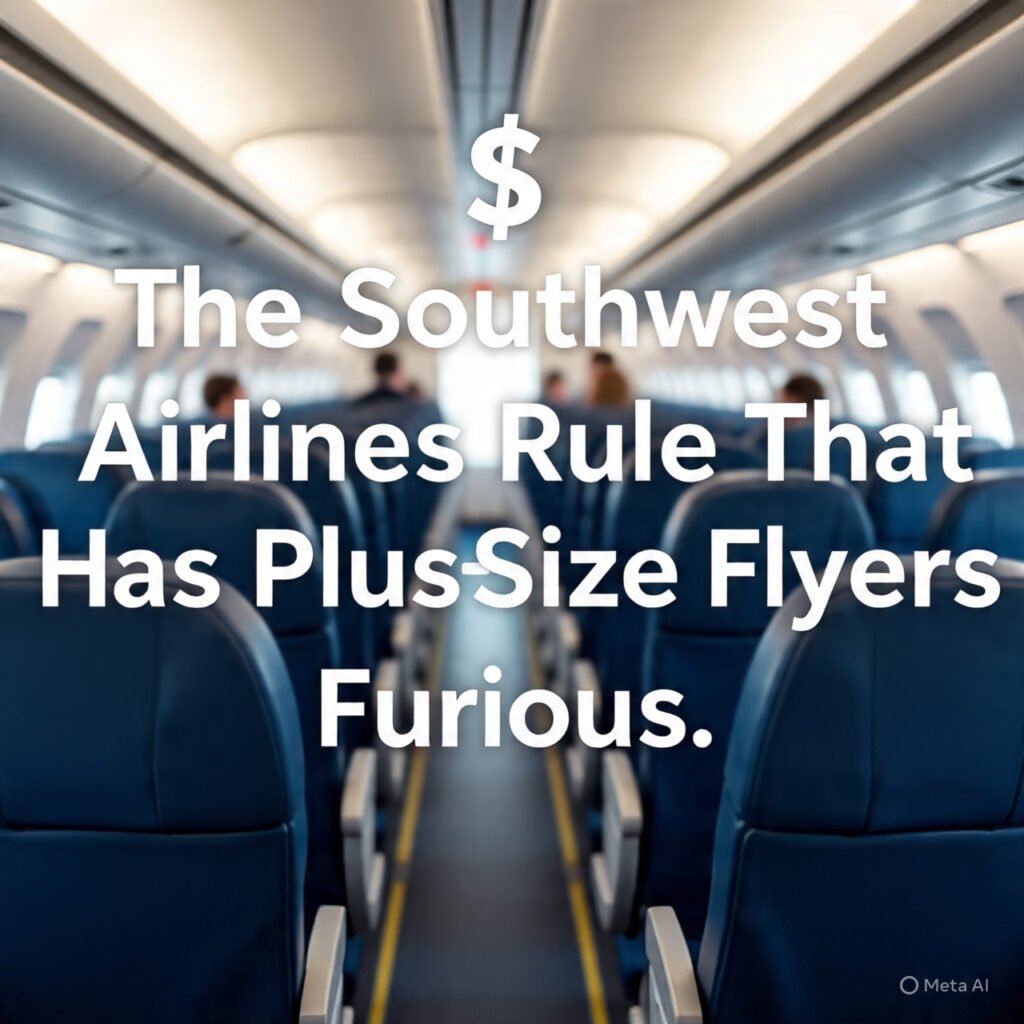The skies were once a little friendlier for plus-size flyers, thanks to a long-standing and progressive policy from Southwest Airlines.3 For decades, the airline’s “Customer of Size” policy was a beacon of hope, allowing passengers who needed extra space to travel comfortably without bearing the prohibitive cost of a second seat. This policy not only earned Southwest a loyal following but also set it apart from its competitors. However, a significant and controversial change is on the horizon. As part of a larger strategic overhaul, Southwest Airlines is tightening its rules, a move that has sparked outrage and concern among the plus-size community.4 This detailed article examines the history of the policy, the specifics of the new changes, and the far-reaching implications for travelers of all sizes.
Table of Contents
A Legacy of Inclusivity: The Original Customer of Size Policy
For over 30 years, Southwest Airlines operated with a unique philosophy that prioritized customer comfort and convenience. A cornerstone of this approach was its Customer of Size policy. Unlike other airlines that require larger passengers to purchase two seats upfront, Southwest offered a different, more flexible solution.
The original policy was designed with the understanding that airplane seats are not one-size-fits-all. The rule stated that a passenger was considered a “customer of size” if their body extended beyond the armrest, infringing on the space of the adjacent seat.5 Under this policy, travelers had two main options:
- Pre-purchase and Refund: A plus-size flyer could proactively book and pay for an additional seat next to them.6 After completing their travel, they were eligible for a full refund for the extra seat, as long as it was not needed by another passenger.7
- Airport Accommodation: Alternatively, a passenger could simply arrive at the airport and, if space was available, request a second, complimentary seat from a gate agent.8
This policy was celebrated for its dignity and respect for the customer. It removed the anxiety of having to pay double the fare and ensured that all passengers, regardless of body size, could have a comfortable and safe flying experience. For many, it was the sole reason they chose to fly Southwest Airlines over other carriers.
The Winds of Change: Introducing a New Era of Travel
In a series of strategic shifts, Southwest Airlines has begun to dismantle some of its most iconic customer-friendly policies.9 Alongside the introduction of assigned seating and the potential end of its “Bags Fly Free” policy, the airline announced a major update to its Customer of Size rule, effective January 27, 2026.10 This date is significant as it also marks the official transition to assigned seating, a move that fundamentally changes how passengers navigate the cabin.
The new policy shifts the financial burden and risk back onto the customer. According to the updated Southwest Airlines policy, plus-size travelers who encroach on a neighboring seat will now be required to purchase a second ticket in advance.11 While a refund is still possible, it comes with strict new conditions that make it far less certain.
The new refund conditions are:
- The request must be submitted within 90 days of the flight.12
- Both tickets must be purchased in the same fare class.13
- The flight must depart with at least one empty seat.14
This last condition is the most significant point of contention. In a world of increasingly full flights, the likelihood of a last-minute empty seat is slim. This change fundamentally transforms the policy from a guaranteed accommodation to a conditional gamble. The once-free or refundable seat is now a non-refundable expense for many plus-size travelers, effectively doubling the cost of their airfare.
The Broader Context: Why the Change Now?
The decision by Southwest Airlines to overhaul its seating policies is not an isolated event. It is part of a broader, industry-wide trend and a direct response to internal pressures. For years, the airline has operated on a model that stood in stark contrast to its main competitors like Delta Air Lines, United Airlines, and American Airlines.
One of the key drivers behind these changes is the airline’s new management regime and pressure from activist investors, such as Elliott Investment Management, who have pushed for increased profitability and a more traditional business model.15 The old policies, while beloved by customers, were seen as a competitive disadvantage, costing the airline potential revenue. By aligning with industry standards, Southwest aims to boost its bottom line and streamline its operations.16
The move to assigned seating and the revised Customer of Size policy are intertwined.17 Under the old system of open seating, a plus-size flyer could pre-board and find a suitable pair of empty seats.18 With assigned seating, this flexibility is gone.19 The airline argues that by requiring pre-purchase, it can better manage seat allocation and avoid the logistical nightmares of re-seating passengers at the gate.20 However, critics argue this places a heavy burden on a specific group of travelers.
The Backlash: A Community Betrayed
The reaction from the plus-size community has been swift and overwhelmingly negative. Many feel that Southwest Airlines has abandoned a loyal customer base. The policy, once seen as an act of compassion, is now viewed as discriminatory and a significant financial barrier to travel.21
- Financial Exclusion: The most immediate impact is financial. Doubling the cost of a flight can make air travel unaffordable for many plus-size flyers. This change disproportionately affects a specific demographic and can limit their ability to travel for work, family, or leisure.22
- Loss of Dignity: Beyond the financial aspect, the change removes the sense of dignity and respect that the old policy provided. It shifts the burden of accommodation entirely to the passenger, creating anxiety and potential embarrassment at the ticket counter.
- Erosion of Trust: For a brand built on a reputation for being a friendly, hassle-free alternative, this change represents a significant erosion of trust. Many customers feel that Southwest is trading its unique brand identity for a chance to be just like every other airline.
Organizations like the National Association to Advance Fat Acceptance (NAAFA) have been vocal critics of the changes.23 They argue that airlines should be making travel more accessible, not less. They point out that aircraft manufacturers, for their part, have not updated seat sizes to reflect the changing demographics of the population, placing the onus on passengers and not on the industry to provide adequate space.
Key Changes for Plus-Size Flyers
To navigate the new landscape, it is crucial for plus-size flyers to understand the specific changes that will affect their travel experience.
- Advance Purchase is Mandatory: You must now proactively purchase the number of seats you need when you book your ticket. Failure to do so may result in being denied boarding or rebooked on a later flight if there is no available space.24
- No More Free Accommodations at the Gate: The option to request a complimentary second seat at the gate is gone. Gate agents will no longer be authorized to provide a free extra seat.25
- Refunds Are Conditional: The refund for the second seat is no longer a given.26 It is contingent on the flight having at least one empty seat upon departure, a condition that is difficult to predict or rely on.27
- Boarding Procedures Changed: Under the old policy, plus-size flyers could pre-board to secure their preferred seating.28 The new assigned seating model eliminates this benefit, as your seat is assigned at the time of booking.
Understanding the Argument from Both Sides
While the backlash has been significant, it is important to understand the airline’s perspective and the arguments that support the new policy.
The airline’s position is that the policy aligns with industry standards and ensures a more equitable distribution of costs. They argue that a single fare is for a single seat, and occupying additional space should be paid for. This perspective is often shared by other travelers who feel they should not have to be uncomfortably squeezed or inconvenienced because a fellow passenger needs more room.
Proponents of the change also highlight that other airlines, such as Alaska Airlines and JetBlue, have similar policies that require payment for extra seats, and their Customer of Size policies also rely on the availability of empty seats for refunds. Southwest’s shift, they argue, simply puts it in line with its competitors.29
The debate boils down to a fundamental question: Is air travel a public service that should be accessible and comfortable for all, or is it a private service where space is a commodity to be purchased? The Southwest Airlines policy change suggests the airline is now firmly in the latter camp.
Conclusion
The new Southwest Airlines policy for plus-size flyers marks a significant departure from its long-standing tradition of customer-centric travel. While the airline frames the change as a necessary step to align with industry standards and improve profitability, it is viewed by many in the plus-size community as a regressive move that creates a financial and logistical barrier to travel.30 The policy’s shift from a guaranteed accommodation to a conditional gamble on flight emptiness has sparked a crucial conversation about inclusivity, dignity, and the future of air travel. As the new rules take effect, it remains to be seen how they will impact passenger loyalty and the airline’s brand identity.
FAQ Section
Q1: What is the official name of the Southwest Airlines policy?
A1: The policy is officially referred to as the Southwest Airlines Customer of Size policy.31
Q2: What is the primary change in the new policy?
A2: The primary change is that refunds for the second seat are no longer guaranteed.32 They are now contingent on the flight having at least one empty seat.33 Previously, the airline would often accommodate a plus-size flyer with a complimentary seat even on a full flight by rebooking another passenger.34
Q3: Does this new policy apply to people with disabilities who need extra space?
A3: Southwest Airlines states that its new policy applies to anyone who “encroaches upon the neighboring seat(s).” While this includes plus-size travelers, individuals with certain disabilities who require extra space for accommodation may be subject to a different set of rules under the Air Carrier Access Act.35 It is always best to contact the airline’s customer service for specific accommodations.
Q4: How can I request a refund for an extra seat under the new policy?
A4: You must submit your refund request within 90 days of your flight.36 You can typically do this online through the Southwest Airlines official website or by calling their customer service. Remember that the refund is not guaranteed and depends on the flight’s occupancy.
Disclaimer
The information provided in this article is for general informational and educational purposes only. It is based on publicly available news reports and official statements as of the publication date. Policies and regulations are subject to change without notice. Readers are advised to consult the official Southwest Airlines Contract of Carriage and the company’s official website for the most accurate and up-to-date information regarding their specific travel needs.
Affiliate Disclosure
This article may contain links to third-party websites or services. Some of these links may be affiliate links, meaning we may earn a small commission if you make a purchase through them. This comes at no additional cost to you and helps support our work in providing valuable content. We only recommend products and services that we believe will be useful to our readers.







